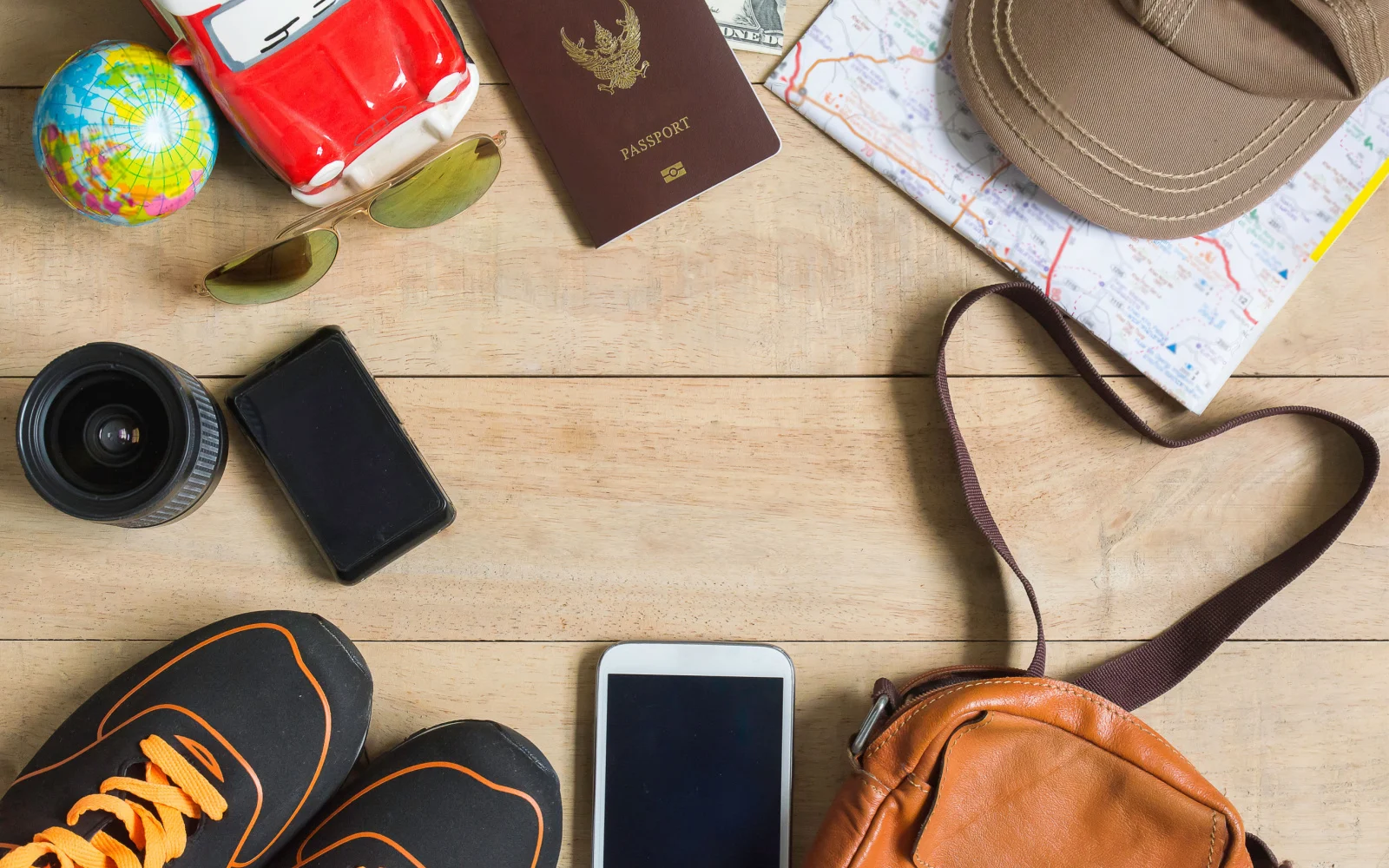Prepare and pack for a trip abroad with a complete international travel checklist! From passports to plug adapters, see what you need to know and stow before you go.
This comprehensive list includes travel documentation, flight reservations, packing essentials, and tips from seasoned international travelers to help you plan your upcoming trip without a hitch.
Pro Tip: Use our simple vacation destination finder tool to uncover the best international destinations for you and your family!
The Complete International Travel Checklist
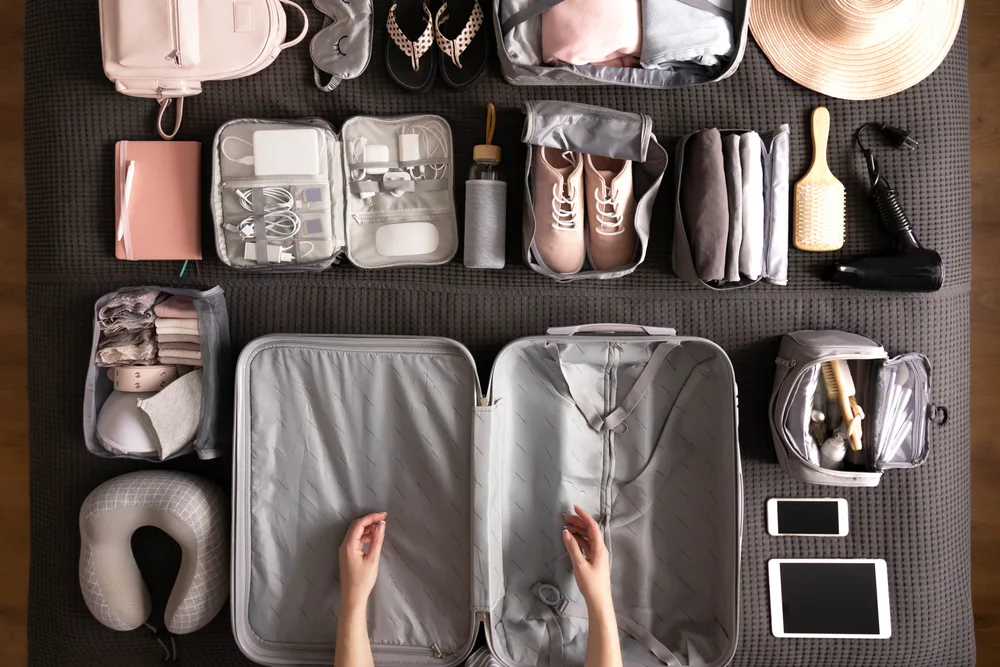
Kostikova Natalia/Shutterstock
There are a lot of moving parts when it comes to planning a trip abroad. Keeping track of everything can be hectic, to say the least.
That’s why you need a clear and comprehensive international travel checklist to follow!
We outline 10 vital steps to take before your international trip below, along with how far in advance you should take each step on the checklist.
The general steps you’ll take before an international trip are:
- Check Your Travel Documents
- Book Your Flights
- Choose a Travel Insurance Plan
- Make a Doctor’s Appointment
- Put Your Mail on Hold
- Grab International Essentials
- Notify Your Bank
- Book Your Hotel
- Compile Emergency Numbers
- Review Your Packing Checklist
These steps should be taken anywhere from 6 months in advance to a week before your trip’s planned departure date.
This will ensure you’re well-prepared with everything you need in order before it’s time to hop on your departure flight.
Let’s take a look at all the things you’ll want to check off your list before your upcoming international trip!
1. Check Your Travel Documents | 4-6 Months Before Your Trip
- Check your ID
- Confirm passport validity
- Apply for a visa
The first thing to take care of on your international travel checklist? Make sure your travel documents are in order.
Planning a trip abroad only to discover your ID or passport is expired (or that you forgot to get a passport or visa) can be devastating. Head off these concerns by making sure you have everything you need in advance!
Check out your government-issued ID and make sure it’s still valid and meets the criteria for international travel if you’re traveling to destinations considered “domestic,” like Puerto Rico or the U.S. Virgin Islands.
If you’re traveling to international destination(s) that are not U.S. territories, you’ll need a valid passport with at least 6 months of validity remaining.
It can take 10-13 weeks to process a passport application, plus 2 weeks for the agency to receive your passport and 2 weeks to mail it to you.
To be on the safe side, apply for your passport as early as possible to ensure you get your passport in time with no unforeseen hiccups delaying your travel.
You can apply for an expedited passport, but you’ll need to have travel plans within the next 14 days and you’ll be cutting it awfully close!
The destination you’re visiting may also require you to apply for a visa before your trip. You can search online to determine whether or not a visa is needed and submit an application online.
There are currently 185 countries you can travel to without a visa as long as you have a valid U.S. passport.
2. Book Your Flights | 3-6 Months Before Your Trip

goffkein.pro/Shutterstock
- Book international flights on Sunday to save
- Book flights 3-6 months in advance
- Use travel hacks to find cheaper flights
Starting around 6 months before you trip, you should start looking for international flights and be ready to book as soon as you find a good deal that follows your preferred itinerary.
Analysis shows the best prices on international flights can be found when you book your flight 3-6 months in advance as opposed to further out or at the last minute.
You’ll save about 10% by booking around 6 months in advance. If you can, book your international flight on a Sunday with plans to fly on a Wednesday or Thursday to save even more.
Why? Sunday is the best day to book flights, saving you as much as 15%, and Wednesday/Thursday are the cheapest days to actually fly on an international trip.
We recommend using these 4 websites to book flights: Expedia, Skyscanner, Kayak, and Kiwi. In side-by-side comparisons, these sites found the cheapest and fastest flights.
Other hacks you can use to find cheap flights include searching for early-morning flights, choosing flights with stops, booking 2 one-way fares instead of round trip, and setting up price alerts for your destination.
3. Choose a Travel Insurance Plan | 3-6 Months Before Your Trip
- Browse travel insurance/trip protection plans
- Choose coverage that meets your needs for the trip
- You’ll pay around $95-$250 on average
Travel insurance is a must for international trips. There are 3 basic types of travel insurance available: Trip protection, medical, and comprehensive.
For international trips, you’ll probably want comprehensive coverage that bundles trip protection/cancellation with travel medical coverage.
Comprehensive travel insurance plans will reimburse you 75%-100% for non-refundable, prepaid trip costs, from flights and hotel rooms to rental cars and attraction tickets.
Look for comprehensive travel insurance plans that include CFAR, or Cancel For Any Reason, coverage to have the most flexibility with your trip.
Other notable coverage options are trip interruption (if you need to cut your trip short), emergency medical and evacuations, baggage and travel delays, and accidental death coverage.
Travel insurance can be a real life-saver if something goes wrong on your international trip. And with the average plan costing between $95-$250, it’s well worth the expense.
4. Make a Doctor’s Appointment | 2-4 Weeks Before Your Trip

Branislav Nenin/Shutterstock
- Ensure your prescriptions will last for your trip
- Get a statement documenting your medication dosages
- Contact your health insurance for an RX override
It’s a good idea to make a doctor’s appointment in advance of your international trip to take care of your medication needs and grab a doctor’s statement.
If your prescription will run out while you’re traveling (or you think your travel dates may extend), you’ll want to get another prescription filled for each of your needed medications.
Your doctor may ask to see your flight itinerary to confirm the need for a prescription sooner than expected. Bring it to your appointment to help the process move along smoothly.
You should also ask your doctor for a written, signed statement showing your prescribed medications and dosages (and even your medical conditions, if needed) in case you run into issues at the airport.
This is a good time to call your health insurance provider and let them know about your trip, too. Ask for a trip or vacation override to enable you to get your prescription early.
5. Put Your Mail on Hold | 2-4 Weeks Before Your Trip
- Put mail on hold up to 30 days in advance
- Have the post office hold mail up to 30 days
- Sign up for forwarding if traveling 30+ days
It’s too often forgotten on the international travel checklist, but putting your mail on hold before your journey abroad is key for keeping your home and mail secure while you’re away.
Letting your mail pile up or overflow in your mailbox lets potential thieves know your home is empty, putting you at more risk for a break-in or robbery while you’re away.
At the very least, you risk letting letters, bills, and statements get ruined by weather and wind conditions if you don’t place your mail on hold before you leave.
You can request a mail hold with your specific travel dates up to 30 days in advance of your trip. That makes it easy to check one more thing off the list early and know it’s taken care of!
Create an account on USPS.com or sign into your account, then follow the prompts under USPS Hold Mail to set the service up. You’ll need to confirm your identity during the process.
If you’re traveling for more than 30 days, you can sign up for a forwarding service instead of a mail hold (which only applies to holds 30 days or less).
6. Grab International Essentials | 2-4 Weeks Before Your Trip
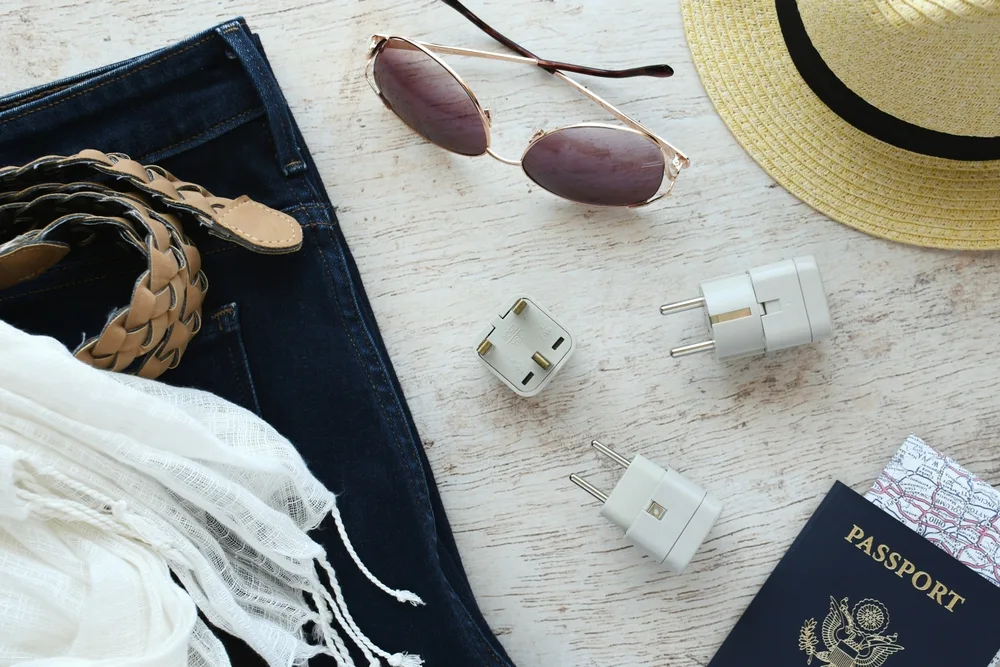
MargJohnsonVA/Shutterstock
- Universal plug adapters
- International SIM card
- Portable chargers/power packs
Depending on where you’re traveling abroad, you may need a universal plug adapter in order to charge your devices and use some of your electrical products on the trip.
Since some electrical outlets abroad use a different power supply and plug configuration, you’ll need an adapter specific to the country you’re traveling to or one that’s universal.
There are currently 15 plug and socket types in use around the world, ranging from Type A to Type O. Find out the type your destination uses or grab a universal adapter and ensure it’ll work there.
You’ll also want to grab an international SIM card or eSIM. This is important to ensure your cell phone works while you’re traveling abroad and is an essential for safety and communication.
You can always wait to buy a local SIM card once you arrive at your destination, but if you like to have everything taken care of in advance, go ahead and buy an international SIM or download an eSIM.
Having access to emergency services as well as staying in communication with family and friends back home requires keeping your phone charged up at all times.
That’s why packing a portable charger or power pack is important for an international trip. Grab a power bank that can juice up your phone if you’re out all day and see the battery start to drain.
7. Notify Your Bank | 2 Weeks Before Your Trip
- Contact your bank and notify them of your trip
- Explain where and when you’re traveling
- Ask about international withdrawal fees
Banks can treat purchases and cash withdrawals abroad with suspicion, viewing them as potential fraudulent transactions if you haven’t notified them of your trip.
That’s why it’s essential to contact your bank ahead of time and let them know where you’ll be traveling and the dates of your trip. They won’t flag your legitimate purchases as fraud or suspicious activity this way.
While you’re speaking with the bank, be sure to ask about any bank ATM fees for international cash withdrawals or any credit/debit card limitations in the country you’re visiting.
It’s always better to have this info ahead of time so you don’t make an expensive mistake and rack up foreign transaction fees! You can always use cash after exchanging currency once you arrive to avoid these fees.
8. Book Your Hotel | 1-2 Weeks Before Your Trip

DenPhotos/Shutterstock
- Book international hotels a week or two before your trip
- Booking international hotels on Thursday saves money
- Don’t book more than 2 weeks before your trip
Booking your hotel is one of the final preparations you’ll need to make on your international travel checklist. Booking a hotel too early could cost up to 8% more.
Instead, wait until a week or 2 weeks before your departure date to book an international hotel. This is when you’ll start seeing big savings on nightly rates of up to 18%, according to Skyscanner.
Unlike flights, last-minute hotel bookings are still a great way to save money. The only downside is that room availability may be more limited.
You can always continually check availability with the hotel you’re considering leading up to your trip and snag a room early if you think they’ll book up.
Just ensuring you book your hotel reservation on a Thursday can save you up to 6% on the total cost. It’s worth setting a reminder to book your reservations on the first or second Thursday prior to your trip!
If you happen to be traveling in July, the cheapest month to book a hotel internationally, you’ll save up to 9% more.
9. Compile Emergency Numbers | 1-2 Weeks Before Your Trip
- Emergency contacts (family, doctor, lawyer, etc.)
- Emergency numbers abroad
- US embassy/consulate numbers
It’s not enough to have emergency numbers saved in your phone for an international trip – if you lose it, it gets stolen, or it’s damaged, you may not able to access those numbers.
Make a list of the following numbers and write them down to keep with you: Your emergency contacts at home, local emergency numbers, and the numbers for the US embassy or consulate near you.
While “911” is the emergency number for the US, the emergency numbers abroad are different. You should make a note of these numbers for your destination in the event of an emergency.
Take a look at a list of emergency numbers for different countries here. Bookmark the list, or better yet, write down the local numbers and keep them on you while you’re traveling abroad!
Make note of US embassy or consulate numbers where you’re heading and keep them handy. If something happens and you need help, you can call +1 202-501-4444 while overseas to get help from the US.
Should you lose your passport or have it stolen during your trip, you can call the number above for assistance.
10. Review Your Packing Checklist | 1-2 Weeks Before Your Trip
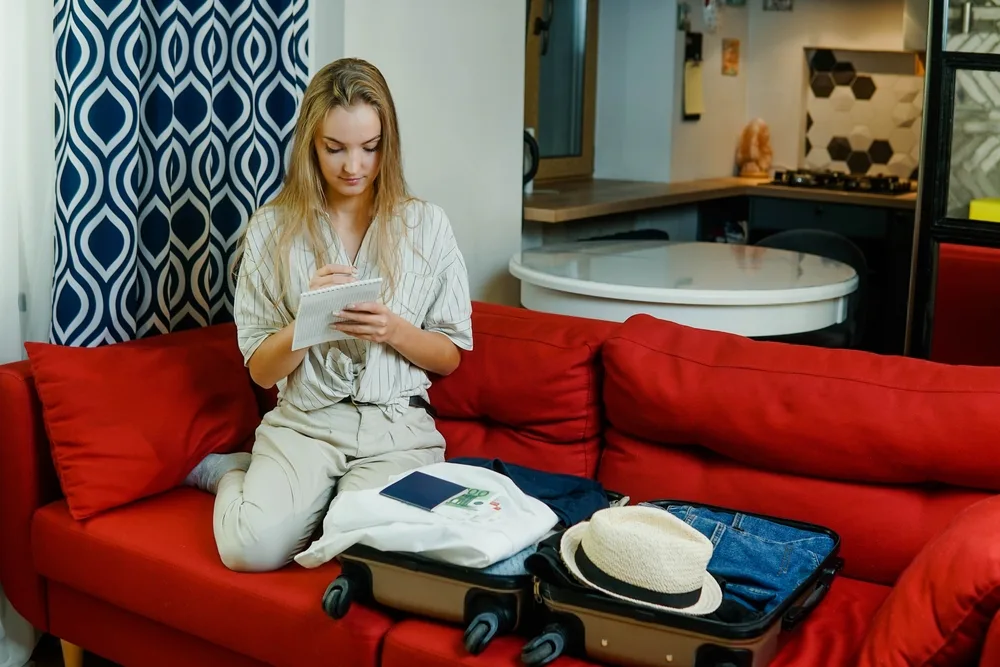
Gleb Usovich/Shutterstock
Your international packing checklist will likely be a lot longer than your list for shorter domestic trips, so it’s important to get a comprehensive look at the items you’re bringing to avoid leaving anything out.
Your packing checklist will vary depending on your destination, the time of year you’re visiting, and the activities you have planned, but here’s a general international packing checklist:
- Travel documents
- Debit/credit cards and cash
- Clothing and shoes
- Weather-specific gear
- Medications and vitamins
- Mobility/healthcare devices
- Toiletries
- Devices, chargers, and adapters
- International SIM card
- TSA-approved luggage locks and tags
- Entertainment/reading materials
- Daypack or lightweight carry-on bag
You should also make note of items you’re not allowed to bring on an international flight or in your carry-on bag. You should review the rules for your departure and arrival destinations.
This list includes firearms (unloaded in checked bags only), knives (checked bags only), fresh fruits and veggies, meat products, counterfeit goods, illegal drugs, explosives and flammable items, and more.
When you’re packing up your carry-on bag, make sure you’re following the TSA’s 3-1-1 carry-on liquid rule. Items in checked bags don’t have to follow this rule.
You’re only allowed to bring liquids (includes gels, creams, pastes, and aerosols) in 3.4 ounce or smaller containers that fit into a single quart-sized, clear bag. You can usually fit about 9 containers of this size in the bag.
Any prescription medications you bring should stay in their original bottles or packaging, clearly showing your name, the healthcare provider’s name, generic and brand name, and dosage.
We recommend downloading trip planning apps like PackPoint to help you stay on top of your international travel checklist. You can tap to check off items as you pack and get recommendations for weather-specific gear for your location.
Don’t forget to pick up TSA-approved luggage locks to secure your items during transit and at the airport.
You can find these locks online, along with luggage tags made of sturdy silicone that lasts longer than the paper tags.
Things to Consider
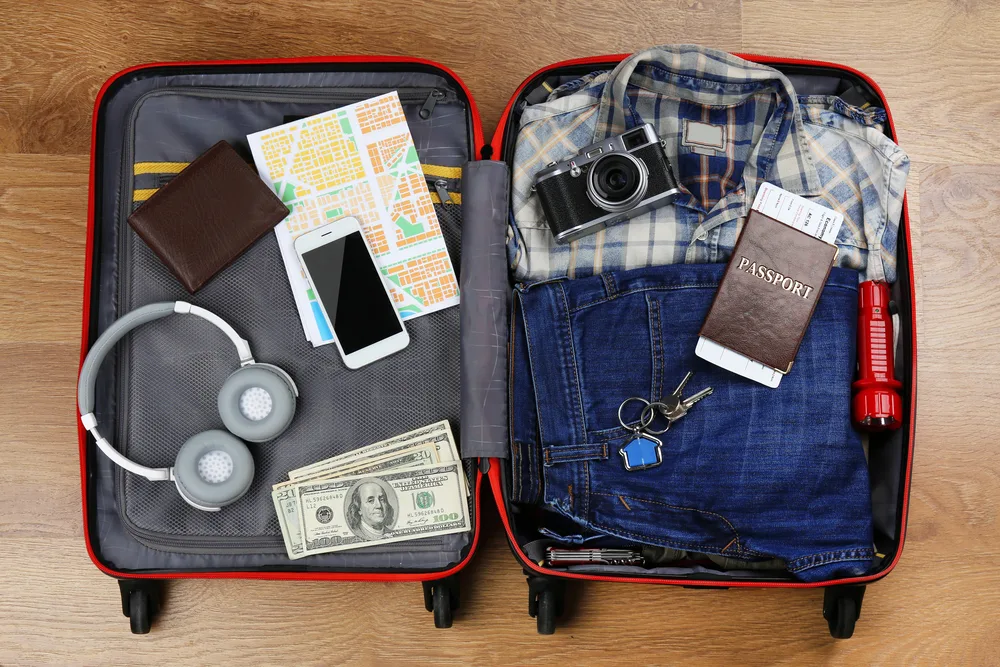
Africa Studio/Shutterstock
Your international travel checklist is only helpful if you actually use it! Here are some additional tips and considerations to keep in mind that make it easy to stick to your list.
- Make a list and check it twice. Every step you’re taking before your international trip should be written or typed out somewhere you can see it daily. Refer to the list often and include deadlines of when each item needs to be completed by. Cross things off as you go, leaving the last-minute preps (like actual packing) for the bottom of the list.
- Keep the time difference in mind. When you arrive in your destination abroad, you’ll be in a different time zone and should take those differences into account. Medications, sleep schedules, meal times, and more can be thrown out of sync with the time differences, so consider how you’ll handle it before you go (and talk to your doctor about medication time differences).
- Check the rules for all countries you’re visiting. Your departure country has its own rules for allowed and prohibited items that may differ from your destination(s). Check rules online with each country’s border protection and customs agencies to ensure you’re only bringing allowed items.
Frequently Asked Questions

Jacob Lund/Shutterstock
Still have questions about making or following an international travel checklist? Check out the most frequently asked questions below to learn more.
What do I absolutely need for international travel?
Items that you absolutely need for international travel include passport, ID, and visa (if applicable), debit/credit cards and cash, medications and vitamins you regularly take, universal plug adapters, and an international SIM card.
Bring your usual packing list for a trip as well - clothing and shoes for the local weather/climate, toiletries that follow the TSA 3-1-1 rule, devices and chargers you’ll need, and a lightweight daypack for outings.
What should I pack for a 10 day international trip?
You should pack enough clothes and shoes for a 10-day international trip, which is usually about 6-7 tops, 3-4 bottoms, 10-12 pairs of socks and underwear, and 2-3 pairs of shoes.
You’ll also need to pack your medications and supplements, toiletries for daily use, money, devices, chargers, plug adapters, and an international SIM card for a 10-day trip.
Are packing cubes really worth it?
Packing cubes are well worth it. They save a lot of space (compression cubes) and organize a packed suitcase incredibly well. You might use one packing cube for clothing or undergarments, another for electronics and accessories, one for cosmetics, etc.
When you’re looking for items you need in your suitcase or separating items for screening, packing cubes really simplify and organize the process. Bonus: They can help you keep dirty clothes separated and stowed at the end of your trip.
Is it better to roll or fold clothes in a suitcase?
If you’re looking to make your items as compact as possible, rolling clothes in a suitcase has the most space-saving power. Folding clothes works better for natural materials like cotton or linen, which easily wrinkle when rolled.
Roll up tops and bottoms made of synthetic blends or denim, leaving natural fibers for folding. You’ll still save lots of space without as much wrinkling.
Can I use ziplock bags instead of packing cubes?
Ziplock bags are a good substitute for smaller packing cubes, but if you’re using the common sizes (sandwich, quart, and gallon), you won’t be able to fit as much in a ziplock bag as you would in larger packing cube sizes.
There are larger ziplock bag sizes that go up to 2 gallons (XL), but you’ll probably find that they’re only a good substitute for packing cubes in a pinch. If you travel often, get the packing cubes.
So, Ready to Use the International Travel Checklist?
As soon as 6 months away from your planned departure date, you can start ticking items off the international travel checklist in preparation for your trip.
If you’ve already got a valid passport and have applied for your visa (if needed), you can go straight to booking your flights about 3-6 months out and purchase travel insurance to get the ball rolling.
From there, taking care of the “little” things that are actually a big deal, like arranging to get your prescriptions early and putting your mail on hold, helps you prepare for a seamless trip.
Don’t forget to grab the essentials (universal plug adapters, international SIM, and portable chargers) and let your bank know you’ll be out of the country.
Finally, copy down all the emergency numbers and info you might need while traveling and go over your complete packing list with a fine-toothed comb to avoid leaving anything out.
When you start your trip with a comprehensive international travel checklist, you’ll feel well-prepared for the journey and get your trip started on an organized, positive note!



